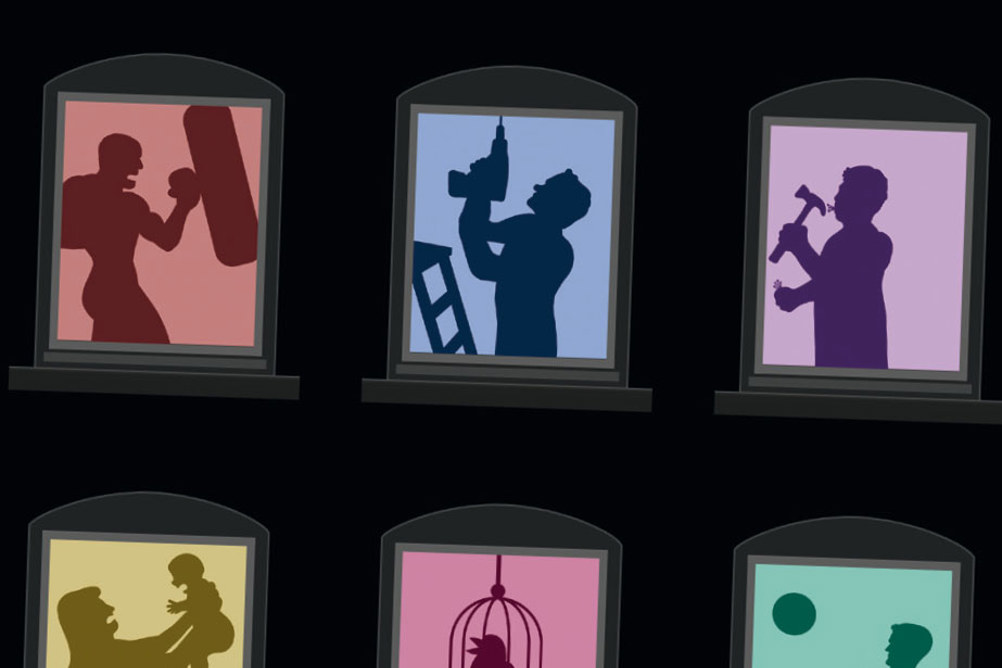
Introduction
During the time of the coronavirus pandemic and lockdowns, some people found that their neighbours (particularly those living above them) were a bit of a nightmare. People in blocks of flats or houses with multiple occupants often struggle to cope with who is above them: the lockdown only made it worse.
Learning objectives
- To create dramatic scenes from a realistic living situation
- To develop credible, sustained characters driving a storyline forward
- To collaborate with others.
Resources:
Channel 5, The Nightmare Neighbour Next Door www.channel5.com/show/the-nightmare-neighbour-next-door
Harassment from your neighbour www.nfh.org.uk/harassment-from-your-neighbour
Hints and Tips on Dealing with Troublesome neighbours www.problemneighbours.co.uk/hints-tips-dealing-with-troublesome-neighbours.html
Warm-up (10 mins)
In threes or fours, set up a short scene where a baby has cried for so long that neighbours knock on the door to discover a young single mother unable to cope. What is the outcome?
Then try the same setting two days later, when there has been no baby noise whatsoever. The neighbours knock again to find the single mother pretending all is well.
Teacher-led discussion (10 mins)
Ask the question: ‘How much can we, or should we, interfere in the affairs of our neighbours who are not our family or responsibility?’
What if they are really difficult to deal with?
Discuss any student experiences of living with problematic neighbours above, below or next door. Can anything ever be done?
What was it like during lockdown? What other reasons might people be unable to escape neighbours? Illness? Fear? Hiding something?
Could things ever get so bad that they would either want to hurt or help these neighbours?
Challenge students to think how a drama can be made from such a situation. Think of characters that will make the story believable.
You could read the poem by Ogden Nash, The People Upstairs www.poemhunter.com/poem/the-people-upstairs
Outline of a story (10 mins)
In groups of four or five, students should make a drama made from three snapshot moment scenes about residents of a flat with ‘neighbours from hell’ upstairs. They must decide why they are cooped up indoors and cannot get out, and whether they call for help or tackle upstairs head on.
Setting
In a flat, with unseen flats above and below.
Characters
Extended, three-generational family living in cramped conditions. Parents are in charge, dealing with teenagers and their own parents.
Does anyone have sympathy with the people upstairs?
Remember, the best drama often comes from credible characters under stress.
Questions to answer
How old is everyone? What is the source of income? How do the teens get on with each other? With the parents? With the grandparents and vice versa?
What secrets do they carry?
How long have they tolerated the disruption upstairs?
Scenes
Three short, snapshot moments, which could cross-cut to a different order:
- Establishing
- Crisis/conflict with upstairs
- Some time later.
The crisis
Are the people above mysterious, involved in drugs, criminals, old people, young people? Do they make noise 24/7, litter stairs, keep four barking dogs? Do they party all night? Play drums? Argue and fight? Are there signs of domestic violence?
What causes the big crisis outburst?
Are the people downstairs any better?
Resolution
An hour, day, week or year later
How are things going to continue?
Devising (25 mins)
Encourage groups by circulating, ensuring everyone is included, no inappropriate material or language are used, characters are shaping up believably, and they are using drama techniques to tell the story e.g. mime, voice, gesture, proxemics, physicality, monologues and minimal props/furniture.
Stretch, challenge, and includeYou will be aware of the need to include all students, to be sensitive to racial, cultural, faith and gender needs, to socially distance if required, and to consider the mental stresses students may have been under.Stretch the more able with a couple of monologues from someone from upstairs explaining a different perspective.
Sharing and showing so far (25 mins)
Depending on time, ask groups to share one scene (their choice) or one group to share their entire piece.
Reviews (10 mins)
Invite two students to self-evaluate in a sentence and two others to peer review in a sentence while you add constructive commentary.
Following up
A similar structure could make a crisis drama with characters under pressure from the people opposite, across the road, outside, in the car, in the supermarket or inside someone's head.
